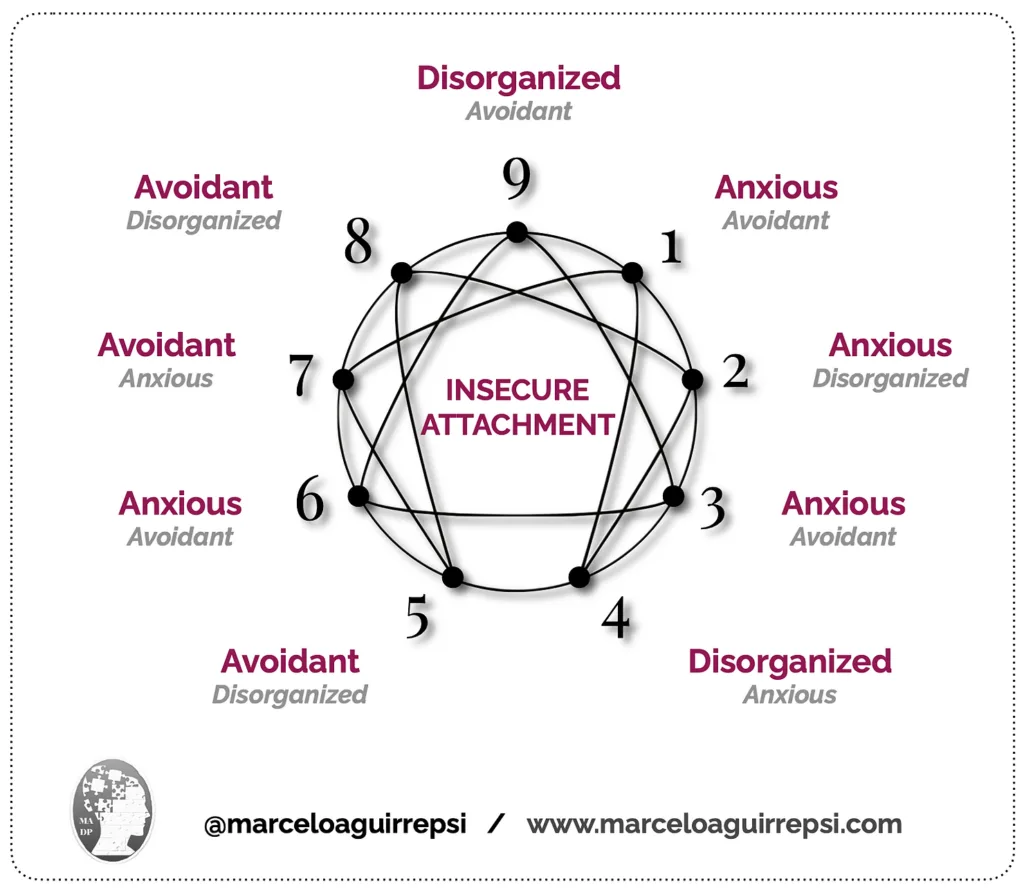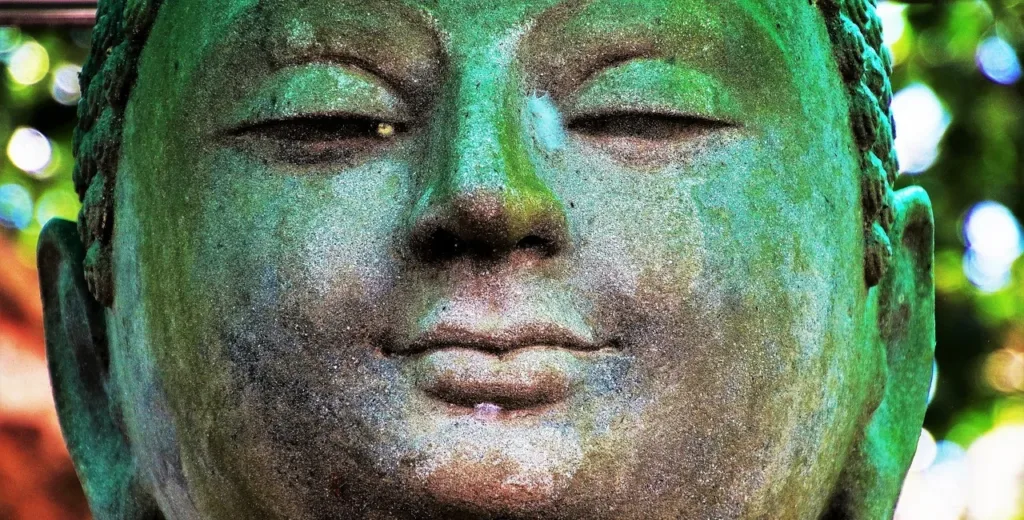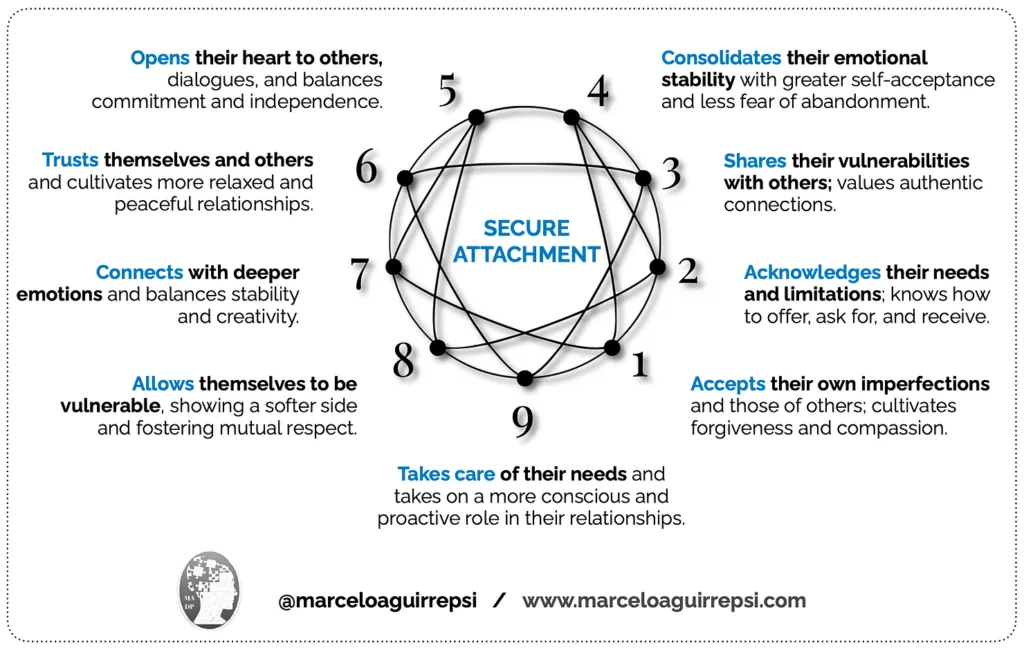
The Enneagram of Attachment. Applying the Attachment Theory to the Enneatypes

Origins of the Attachment Theory
The Attachment Theory was developed in the 1950s with the pioneering work of the British psychologist John Bowlby and later expanded in the 70s by the American-Canadian psychologist Mary Ainsworth. This model identifies child attachment patterns as lasting styles of emotional bonding between individuals. At the heart of Bowlby's revolutionary concept is that early attachment experiences between the young child and their closest caregivers will strongly condition the primary and secondary style of emotional bonding that the individual will develop during adulthood and throughout life. These bonds permeate our primary and secondary attachment styles and are particularly evident in our adult relationships, both sentimental and professional.
Secure attachment
While it may seem unusual to relate attachment styles with sympathetic and parasympathetic autonomous responses, secure attachment can be viewed as a conditioned response to a child's experience of growing up in a calm, steady, and harmonious environment.
(Note: Remember that the parasympathetic nervous system is associated with relaxation and enjoyment, while the sympathetic nervous system is more related to reactive responses that seek to ensure survival in situations of high distress.)
To illustrate the safe attachment style, let's look at the following example:
Simon's case
As a child, Simon was raised in a safe, harmonious, and loving environment. From an early age, his physical and emotional needs were mainly met timely. His parents had a parenting style with him in which they showed him clear rules and limits while being empathetic with the child, open to dialogue, and willing to listen to each other. These favorable and consistent experiences throughout his upbringing allowed him to develop a safe attachment style.
As an adult, Simon finds it easy to establish close connections, feels comfortable giving and asking for help, and can work in a team with a healthy interdependence or synergy. Both in his couple relationship and at work, Simón proves to be open, empathetic, and assertive in handling conflicts in a constructive way: he listens attentively, clearly communicates his viewpoints, and establishes fair limits respectfully, always looking for equitable agreements.
-
A healthy environment — A harmonious, stable, and loving environment in which the child's physical and emotional needs are addressed in a timely manner.
-
A balanced parenting style — Caregivers establish clear rules and limits while being empathetic, open to dialogue, and willing to listen to each other. // Note that his parenting style is known in Developmental Psychology as an "authoritative" style. It differs from the authoritarian (in which there is no listening), the indulgent (in which there are no clear and healthy limits), and the indifferent (in which there is no care in time and form) (Morris & Maisto, 2009).
Insecure attachment
-
Anxious attachment — The primary caregiver is sometimes present. The child is fearful and ambivalent about their caregiver and sometimes behaves excessively demanding with anybody from whom they receive attention.
-
Avoidant attachment — The primary caregiver is rarely present. The child manifests as withdrawn, distrustful, and pessimistic. They tend to move away from those who show interest in interacting.
-
Disorganized attachment — The primary caregiver is mostly absent and/or rejects the child (who might suffer from any abuse). The child shows emotionally unstable and impulsive, aggressive and/or self-harmful, and alternates between responses of affection and aggression with the caregiver and close ties in general.
Teresa's case
As an adult, Teresa finds it difficult to establish close connections. She feels interpersonal relationships are overwhelming and exhausting. She often mistrusts the intentions of those who approach her affectionately, and sometimes, she oscillates between excessive demand for attention, withdrawal, and irritability in dealing with those she is close to.
Trust and personality (ego) formation
For current Psychology and Evidence-Based Psychotherapy, it is a fact that experiences form beliefs, and these crystalized as mental patterns (mindset) making up our ego or personality, that is, the psychic structure through which we experience the world, others and ourselves (Mikulincer & Shaver, 2010).
«The ego is a psychic structure that is based on crystallized beliefs about who we are and what the world is. We experience ourselves and the world through the filter of this structure. (…) Our ordinary confidence in people and situations is highly conditional and dependent on familiarity and reliability. Painful experiences or personal betrayals can disrupt our trust in the external and internal elements of our lives.» (Almaas, 2012, pp. 31-32)
Having favorable experiences (especially at an early age), such as feeling cared for, loved, heard, and valued, forms a secure attachment, predisposing us to hold optimistic beliefs. In addition, from a complementary viewpoint, we can state that the same positive experiences that predispose us to develop a secure attachment also connect us with a deep, preverbal trust (considered by some to be "spiritual"), a phenomenon known as basic trust, the trust in the inherent goodness of the world and ourselves as part of the Whole (Almaas, 2002).
Conversely, traumatic and highly painful experiences (abuses, abandonment, mourning, violence, humiliation…) disconnect us from basic trust and produce in the psyche a strong tendency to sustain pessimistic core beliefs about how the world works (others), how valuable we are (ego), and what we can hope (future).
The Enneagram of Insecure Attachment Styles

Summarizing, we have the following primary and secondary insecure attachments for each enneatype:
-
Anxious / Avoidant: 1, 3, 6
-
Anxious / Disorganized: 2
-
Avoidant / Anxious: 7
-
Avoidant / Disorganized: 5, 8
-
Disorganized / Anxious: 4
-
Disorganized / Avoidant: 9
Please note that since the highly stressful early experiences for the child produced mnemonic traces that are activated with later experiences of distress in emotionally significant or intimate contexts, the adult tends to react sympathetically according to the insecure attachment style they have developed, as previously stated.
Thus, we can consider that the primary insecure attachment style shows a habitual tendency to relate emotionally in a particular way, i.e., a habitual pattern of thinking, feeling, and reacting to manifestations of affection in contexts marked by moderate to high levels of distress. The secondary style emerges as a complementary strategy in response to high distress, serving the primary strategy, namely, fleeing (avoidant); demanding attention (anxious); or alternating between withdrawal, approach, and aggression (disorganized).
Next, let's look more closely at each of these correlations.
Primary Anxious, Secondary Avoidant
Type 1
-
Striving for perfection and order (doing the right thing), they may have grown up in environments where errors were not tolerated; hence, their anxiety about adhering to rules and meeting expectations (which they will manifest in their interpersonal relationships, especially in romantic and work contexts).
-
Their secondary avoidant style is a learned strategy to dodge error and avoid criticism and conflict (Note: the sexual subtype may confront what is "incorrect," thus showing a greater secondary tendency toward the disorganized style).
Type 3
-
Driven to achieve success and external approval, they might have experienced environments where their achievements were predominantly valued, hence their anxiety to excel and appear competent.
-
Their secondary avoidant style toward emotions that might seem a sign of weakness (sadness, guilt, emptiness) is a strategy to elude any form of failure or incompetence.
Type 6
-
Concerned with security and loyalty, they may have faced environments where protection was uncertain, hence their generalized anxiety.
-
Their secondary avoidant style is a defense mechanism against abandonment or betrayal, leading them to distance themselves preemptively (Note: the sexual or countertype Six may be more oriented toward confronting a threat or possible betrayal, predisposing them to a secondary disorganized style).
Primary Anxious, Secondary Disorganized
Type 2
-
Focused on being loved and needed, they may have received affection and attention conditionally in childhood in exchange for meeting the needs of others, hence their anxiety to please and seduce.
-
Their secondary disorganized style arises as an expression of the confusion and frustration they feel due to the inconsistency or unreliability of the love and support they receive from others.
Primary Avoidant, Secondary Anxious
Type 7
-
Constantly searching for entertainment and variety, they tend to avoid delving into deep emotions due to early experiences where their emotional needs were not adequately met. Hence, they tend to seek happiness in external and superficial things.
-
Their anxious secondary style emerges in the most intimate relationships, revealing underlying fears of becoming trapped in some form of emotional discomfort or being deprived of their freedom (fear of not being able to escape).
Primary Avoidant, Secondary Disorganized
Type 5
-
Prioritizing independence and knowledge, they developed a primary avoidant attachment style with little emotional expression as a response to experiences that led them to be self-sufficient (intrusive caregivers) in an environment where emotional expression was not rewarded (emotionally distant caregivers).
-
Their secondary disorganized style arises when they feel they must defend themselves from intrusions, becoming cranky and retreating to solitary or intellectual activities.
Type 8
-
Striving to embody strength and maintain control, they developed a primary avoidant attachment style in response to environments where sensitivity was perceived as vulnerability and/or weakness.
-
Their secondary disorganized style arises as reactivity with anger or frustration to what they interpret as challenging advances from others, serving to prove they retain control while protecting their vulnerability.
Primary Disorganized, Secondary Anxious
Type 4
-
Deeply in touch with their feelings and search for identity, they might have experienced early emotional turmoil or neglect from their caregiving and protective figures, predisposing them to develop a primary disorganized attachment style, oscillating between seeking connection and withdrawing for fear of rejection, with intermittent outbursts of anger and frustration.
-
Their secondary anxious and dramatic attachment is a consequence of feeling misunderstood and fearing not being loved.
Primary Disorganized, Secondary Anxious Avoidant
Type 9
-
Typically disconnected from their deep emotional needs (hence their appearance of imperturbability), they might have grown up in environments where their individual needs were overlooked, predisposing them to form a primary disorganized attachment style. They feel confused about how important they are and how they should assert themselves before those who seem to ignore them, oscillating between resignation, concern, and frustration.
-
Their secondary avoidant and procrastinating style is a coping mechanism to avoid conflict and uncomfortable emotions.

The Enneatypes with Secure Attachment
When we feel calm, we perceive that the present environment is not a threatening place where we must defend ourselves; when we relax and enter into trust, our parasympathetic nervous system activates, inducing relaxation and fostering experiences of enjoyment and a general sense of well-being.
Since it is a parasympathetic state, the secure attachment style involves decreasing muscle tension, relaxing the diaphragm (as achieved through the practice of deep breathing mindfulness), reducing stress hormone levels (adrenaline and cortisol, mainly), and increasing the levels of so-called happiness molecules (serotonin, dopamine, and endorphins, among others) in our brain.
Thus, when we experience a state of relaxation, well-being, and enjoyment in the company of another, the secure attachment style emerges as a manifestation of the best in us. This is exactly what we can appreciate in the Enneagram of secure attachments, each enneatype at its best version (at an optimal psychosocial functioning level, traditionally known as being in connection with the Essence).

It is important to note that self-awareness, emotional regulation, and the quality of interpersonal relationships are interconnected. Hence, each enneatype can significantly benefit from the transformative practice of Mindfulness (and any other meditative or contemplative practice) to develop a more secure attachment style.
Regular practice of Mindfulness, for example, despite its surprising simplicity, is so healing and transformative that it will allow each enneatype to learn the art of arts, learn to be present, relaxed, and open to enjoyment in connection with the here and now. Thus, Mindfulness reduces sympathetic reactivity (characteristic of insecure attachments) and fosters a more parasympathetic response (relaxation and enjoyment), achieving greater resilience under stress and more harmonious and satisfying interpersonal relationships.
Transformative Practices to Move Toward a Secure Attachment Terrain
Type 1
-
To consciously move to a terrain of secure attachment, Ones will significantly benefit from the practice of self-compassion meditation, which will help them accept mistakes and appreciate effort, not just forms, in themselves and others (especially partners and colleagues).
Type 2
-
To consciously move to a terrain of secure attachment, Twos are advised to regularly practice visualization of giving and receiving (particularly imagining natural cycles, thus working with the right hemisphere, the wisdom and humility of nature, like the earth that opens to receive the rainwater and produces plants that return moisture to the environment, creating a cycle of giving and receiving, without selfishness or dependencies). Keeping a journal (diary) of personal needs will also benefit them.
Type 3
-
To consciously move to a terrain of secure attachment, Threes will benefit from regularly recording their emotional experiences in a journal (a journal on emotions). That way, day by day, they connect with their deeper and more authentic internal world, beyond the swings of external judgments and even beyond the successes and failures of life. Also transformative for them will be dedicating regular time to intimate conversations with authentic friends where they can open their hearts without being judged.
Type 4
-
To consciously move to a terrain of secure attachment, Fours are recommended to regularly practice mindfulness of the mountain (visualizing and identifying themselves with the solidity and stability of the mountain) to cultivate equanimity and achieve emotional self-regulation without resorting to external dependencies.
Type 5
-
To consciously move to a terrain of secure attachment, Fives will significantly benefit from dedicating time to regular intimate conversations with trusted individuals (such as their close friends, partner, and close family members) to exercise heart-opening and mutual empathetic listening.
Type 6
-
To consciously move to a terrain of secure attachment, Sixes are advised to regularly practice self-affirmation mantras (such as "I trust myself" or similar) and the practice of the inner smile (slight smile) to deactivate the sympathetic alert state, reduce anxiety, and gradually get used to living in a state of greater relaxation and tolerance to distress.
Type 7
-
To consciously move to a terrain of secure attachment, Sevens are recommended to practice diaphragmatic breathing exercises regularly (anchoring to the present) and to savor each moment with a greater concentration of attention, without escapes or evasions.
Type 8
-
To consciously move to a terrain of secure attachment, Eights will significantly benefit from exercising reconnection with their sensitive side in safe spaces such as individual or couple retreats, self-help groups, therapeutic theater, bio dance, and similar activities.
Type 9
-
To consciously move to a terrain of secure attachment, Nines are recommended to regularly practice self-inquiry exercises that help them reconnect with their needs, for example, using prompts such as "What do I feel? What do I need? What do I prefer?" and similar. In a second moment, they should share the insights obtained from these reflections with a partner or close friends.
Finally, let's remember that the neurosciences, with overwhelming evidence, confirm that our brain is neuroplastic (Machado et al., 2008), meaning we can always incorporate changes in our personality, make rigid patterns flexible, and build new, healthier habits. Moreover, thanks to neuroplasticity, we are more aware today than in the past that personal work does not end with identifying an enneatype, nor with finding one's primary and secondary attachment style. Still, that identification within a system of categories, whatever it may be, is just the first step in an ongoing process of learning, healing, and transformation. May it be so for all of us in the process of awakening.
Until next time!
Marcelo Aguirre
Buenos Aires, Argentina
Licensed Psychotherapist
University Lecturer
Life Coach
References
-
Almass, A. H. (2002). Facets of Unity: The Enneagram of Holy Ideas. Shambhala.
-
Bowlby, J. (1969). Attachment. Random House.
-
Machado, S., Portella, C. E., Silva, J. G., Velasques, B., Bastos, V. H., Cunha, M., ... & Ribeiro, P. (2008). Aprendizaje y memoria implícita: mecanismos y neuroplasticidad. Rev Neurol, 46(9), 543-549.
-
Mikulincer, M., & Shaver, P. R. (2010). Attachment in Adulthood: Structure, Dynamics, and Change. Guilford.
-
Morris, C. G. & Maisto, A. A. (2009). Psicología. Pearson.

